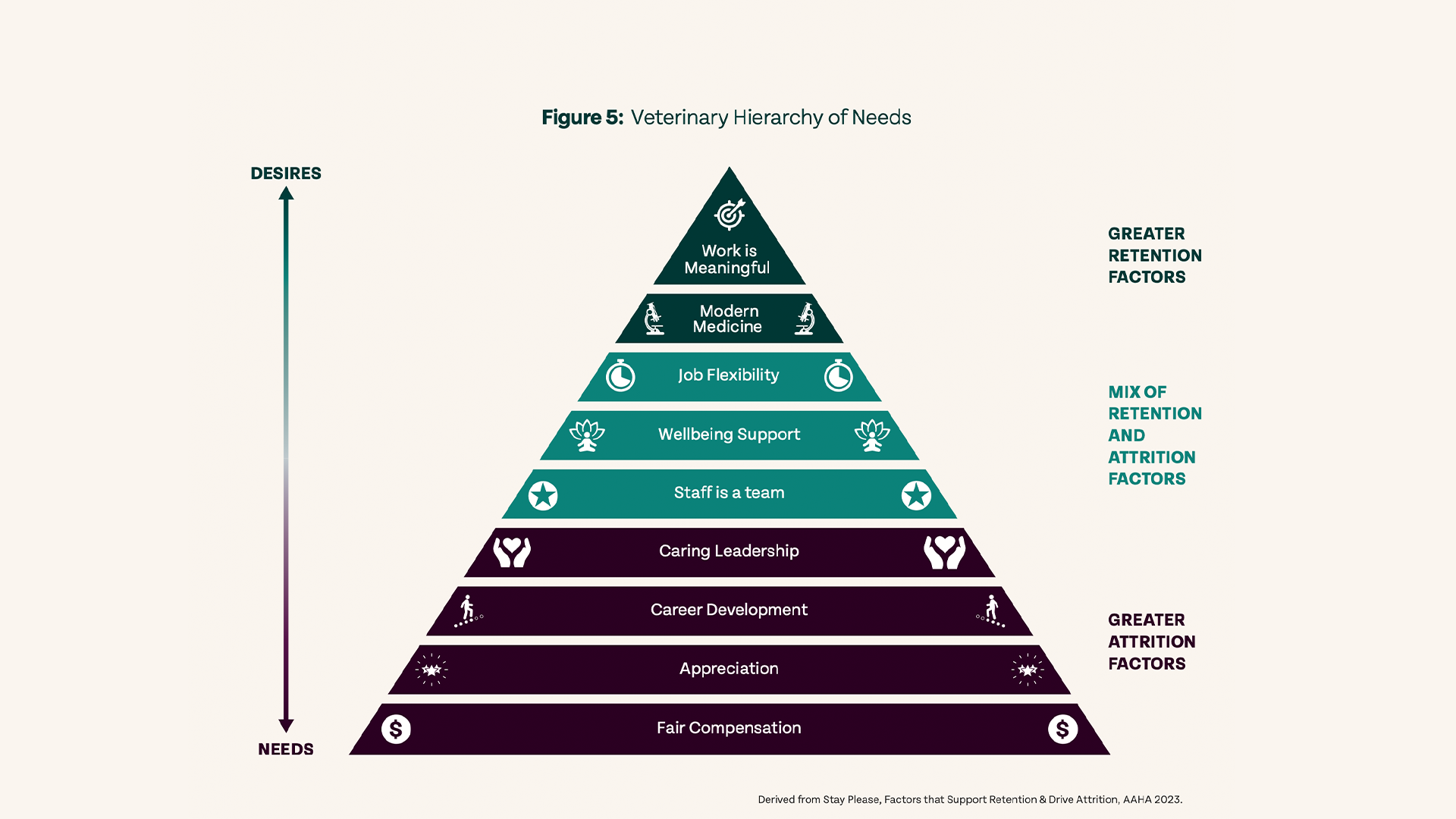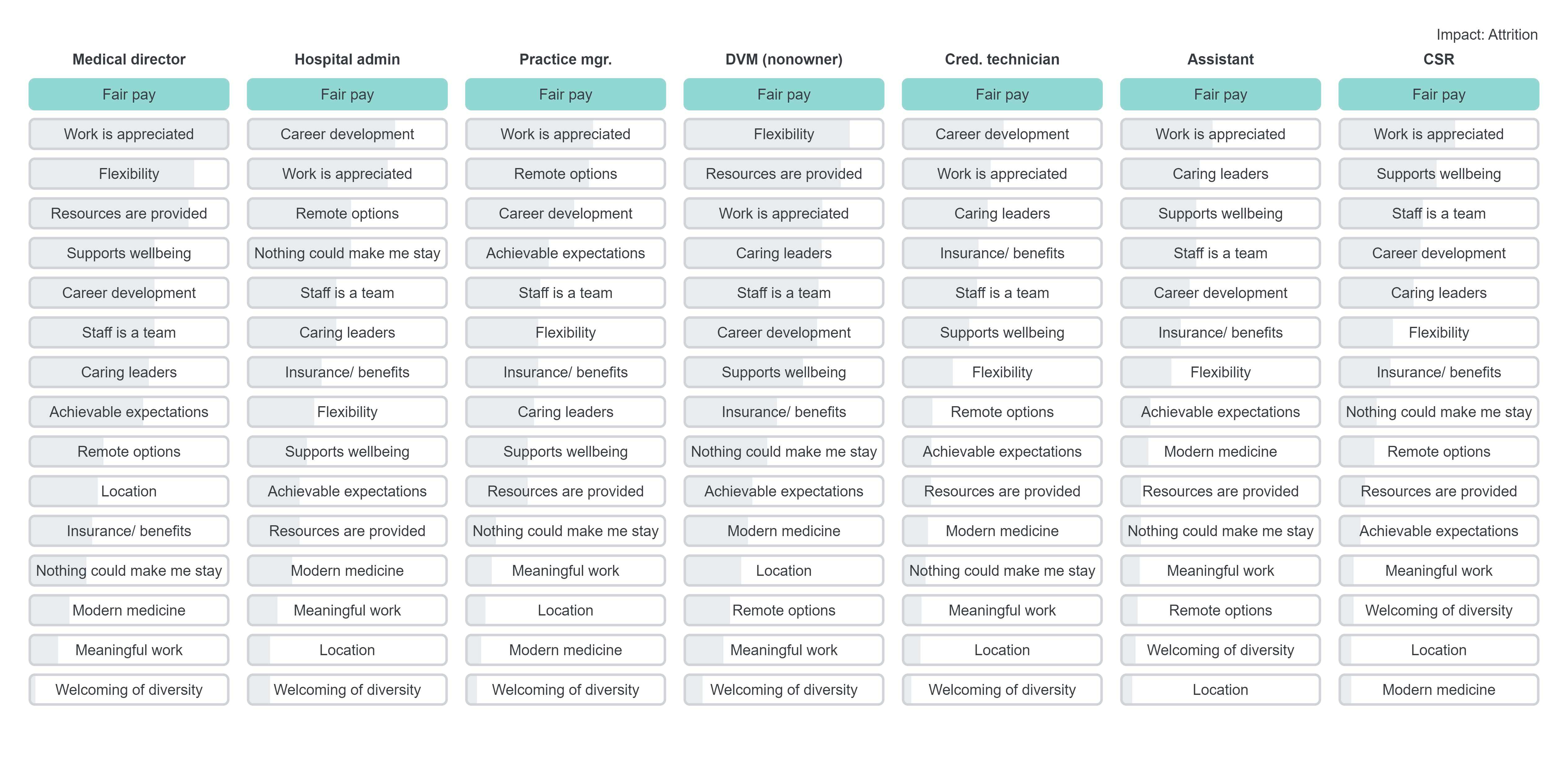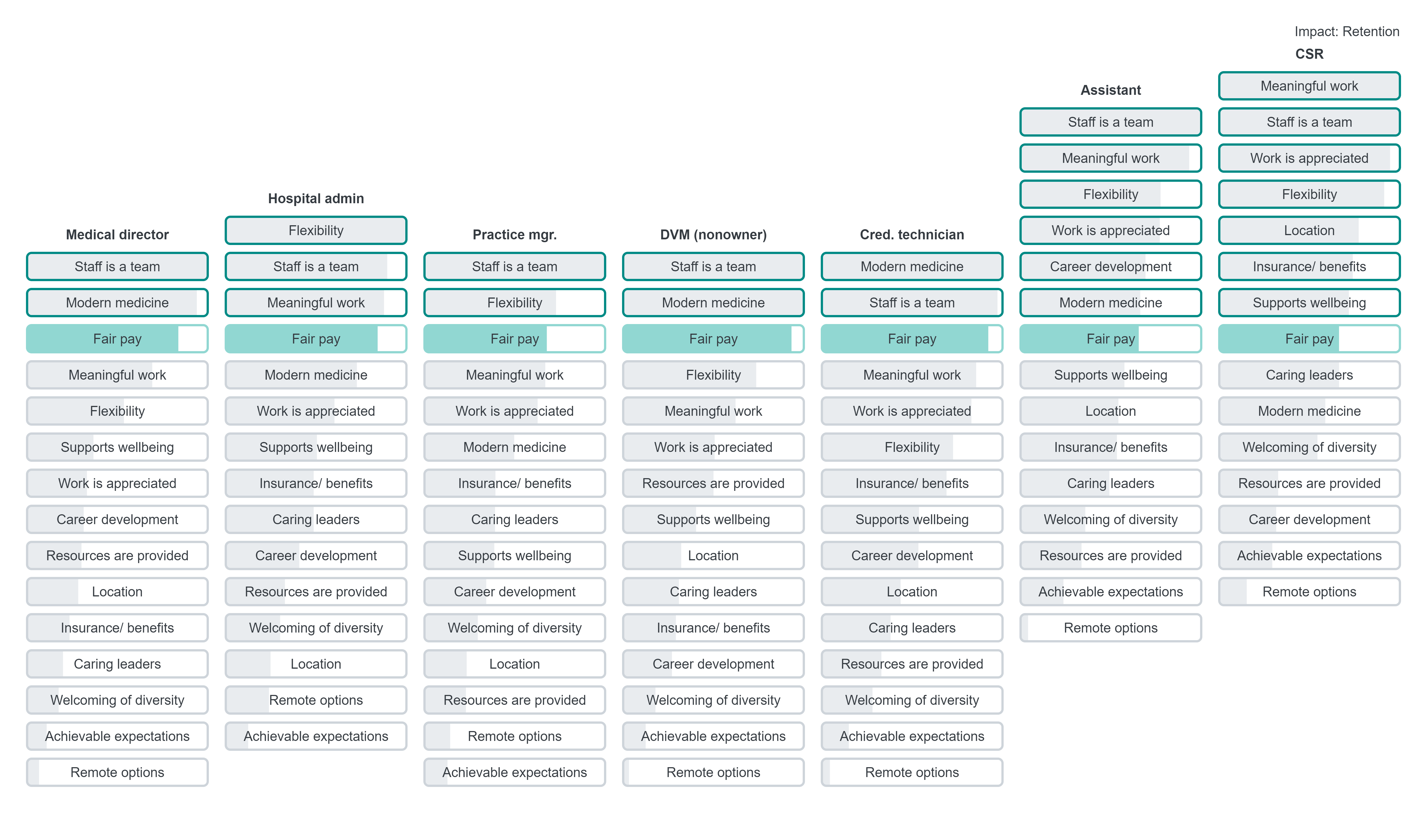Reducing turnover: Which approach is right for you?

The proper path to improved retention depends on your practice.
Turnover is turnover is turnover, right? Not exactly—and the type of turnover a practice is experiencing plays a big role in how they might want to work to improve it.
What does that mean? Let’s look at some (fictional) examples.
Suppose Practice A has low-to-average turnover overall, but the turnover they do experience tends to be specific to just a couple roles—veterinary assistants and customer service representatives. Generally speaking, they’re in good shape, but they’d be in great shape if they could figure out how to make the folks in those roles want to stick around.
Practice B, on the other hand, has been churning through associate DVMs for several years. By the time these veterinarians know the practice and the team, they’re already looking for new jobs, so there’s a rotating cast of doctors. Constantly recruiting, training, and working with brand new veterinarians is taking a toll—on both the remaining staff and the clients they serve. This practice is in crisis.
And then, there’s Practice C, which is losing about 20% of the team each year—and that’s occurring across all roles. Because of this steady, if not massive, stream of widespread loss, they’re nearly always working to recruit and train new team members, all of which puts more strain on the folks who didn’t leave . . . and as that strain increases, even those folks who want to be loyal will, eventually, start exploring their options. Practice C isn’t in big trouble now, but they want to make changes to ensure they stay out of turnover trouble in the future.
Although all three practices would like to reduce attrition, it’s easy to see that their situations differ—and it’s unlikely the exact same solutions will work equally well across the board.
To better understand what solutions would work best for whom, our recent “Stay, Please” study surveyed veterinary professionals to identify the key drivers of attrition, as well as the factors that inspire retention, both for the veterinary profession in general and for individual roles. Our findings led to two different approaches for applying this research: a holistic approach and a role-based approach.
Here’s how to know which one is right for your practice—and how to get started.
The holistic approach
Simply put, the holistic approach is designed to help teams with practice-wide retention challenges—or at least high turnover across multiple roles. This approach focuses on the attrition and retention factors that are most likely to impact the team as a whole at various stages of the retention journey. So, in terms of our examples above, the holistic approach is a good fit for Practice C.
Now, the precise factors a practice should focus on as they begin will depend on just how high their rate of turnover is.
High turnover is an indication that employees feel their basic needs—demonstrated as the factors at the base of our Veterinary Hierarchy of Needs here—are not being met. Chief among those needs, by a long shot, is fair compensation; if you aren’t paying people (especially your nonmedical staff) appropriately, it really doesn’t matter what else you do well, because people simply don’t stay in jobs they can’t afford to keep.

Once fair compensation, along with the other basic needs (appreciation for work, career development opportunities, and caring or inspiring leadership) has been addressed, turnover should slow.
Practices that are already excelling at meeting those basic needs and practices that have made improvements to those factors can move up to the factors that, when lacking, drive attrition, but when done well, inspire retention.
Teamwork is the most important among these; being part of a staff that functions as a team is hugely important across all roles. Flexibility in scheduling and job duties, along with support for wellbeing, are also key at this stage.
By the time these factors are addressed, a practice’s retention rate should be looking quite decent. Employees are likely pretty happy—but there’s still room to improve by taking the final steps toward creating true practice loyalty.
The ability to practice modern and/or sound medicine, along with meaningful work, are factors that greatly influence retention when done well; however, they do not drive people away when lacking.
The role-based approach
While the holistic approach is great for practices experiencing widespread turnover, teams with high turnover in a specific role or roles will be better served by the role-based approach. This approach looks at the attrition and retention drivers that most strongly impact the roles in question, allowing practices to craft a more targeted retention strategy.
The general idea behind the holistic approach remains applicable: Practices with excessive turnover in those specific roles, like Practice B, will want to first address the strongest drivers of attrition for those roles, and as their turnover rates diminish (or if they begin with manageable turnover, like Practice A), they’ll move along to the factors that also inspire retention.
Of course, the key factors vary by role, which means you cannot simply look at our holistic findings—you need to dig into the top attrition and retention factors for the position you’re looking to impact.
When it comes to the factors that are pushing people away, we can begin with the graphic below.

As you can see, the top attrition factor, across all roles, is fair compensation. The factors listed below fair pay are shaded in gray—the amount of gray indicates how strongly each factor impacts attrition. So, if we look at our DVM (nonowner) role, we can see that flexibility in scheduling and job duties and having the resources needed to do their jobs also rank highly. That’s a notable difference from the holistic findings!
Just as with the holistic approach, the idea here is to address those top attrition factors; then, as turnover rates improve, move along to the factors that inspire retention and practice loyalty, shown below with retention factors (as they compare to fair compensation).

You might notice that being part of a staff that functions as a team is at or near the top for every role, while fair pay ranks anywhere between third and seventh. And, if we go back to our DVM (nonowner) role, we’ll see that in addition to staff is a team, the ability to practice modern and/or sound medicine is right at the top. Fair compensation and flexibility in scheduling and job duties remain important, too.
By looking at the top attrition and retention drivers for the roles in which you have high turnover, you’ll develop a clear idea about what matters most to that role. Begin with that role’s strongest attrition drivers, move on to the factors that rank highly in both attrition and retention, then finish strong by focusing on the top retention factors that do not strongly impact attrition.
Knowing what your team needs and wants is the first step toward better retention; next, we take action. Stay tuned throughout 2024 as we share expert tips, resources, and strategies for addressing the biggest attrition and retention factors in veterinary medicine.
This article is part of our Stay, Please series, which focuses on providing resources (as identified in our Stay, Please retention study) to retain the 30% of all veterinary professionals considering leaving their clinical practice. Here at AAHA, we believe you were made for this work, and we’re committed to making clinical practice a sustainable career choice for every member of the team.
Kristen Green Seymour is AAHA’s Copywriter.
Cover photo credit: © Morsa Images E+ via Getty Images Plus
Disclaimer: The views expressed, and topics discussed, in any NEWStat column or article are intended to inform, educate, or entertain, and do not represent an official position by the American Animal Hospital Association (AAHA) or its Board of Directors.
NEWStat Advancements & research News Practice management Retention Study



